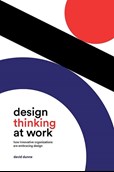- Innovation
Design Thinking in Organizations
How ‘design thinking’ theory is being successfully translated into real-world innovative practice
The benefits of ‘design thinking’ are well documented. It is a process for creative problem solving that can reduce risks associated with launching new ideas, generate both incremental and transformative innovation, and help leaders plan their products, services, and ways of working.
The theory, as originally explained by Roger Martin, Former Dean of Rotman School of Management, is relatively easy to understand. The difficulty, many have expressed, is in how to translate the theory into real-world practice in our increasingly complex business organizations.
 In his new book Design Thinking at Work, David Dunne, Senior Lecturer Emeritus of Marketing and Co-Director of Rotman Teaching Effectiveness Centre, draws on years of research, into how the theory has been applied in organizations, to explain the challenges, barriers and potential pitfalls of design thinking and to offer lessons for achieving success.
In his new book Design Thinking at Work, David Dunne, Senior Lecturer Emeritus of Marketing and Co-Director of Rotman Teaching Effectiveness Centre, draws on years of research, into how the theory has been applied in organizations, to explain the challenges, barriers and potential pitfalls of design thinking and to offer lessons for achieving success.
In the first part of the book Dunne describes the concept, explaining how to think like a designer, how the design thinking process is iterative rather than linear, and why adopting it, as opposed to analytical thinking, can transform our ability to develop strategy and solve business problems. But as he reflects “Exciting as design thinking is – I still find myself passionate about it – it is not easy to apply.”
………………………………………………………………………………………………………….
Dates: June 3–7, 2019 │ Format: In-class study │ Location: Toronto
………………………………………………………………………………………………………….
Would-be design thinkers need to encourage a ‘design mindset’, one of openness, curiosity, experimentation, and agility – attributes that sit uncomfortably in rigid process driven organizations that are watchful over resources and wary of disruption. Yet, numerous organizations have adopted design thinking and in the second part the book Dunne considers the reasons companies from the Australian Tax Office to Procter & Gamble have done so and describes the challenges they have faced.
Considering these challenges, Dunne focuses on three fundamental tensions – inclusion, disruption, and perspective – that those applying design thinking in organizations need to negotiate:
Inclusion – This is about the risk that design thinkers, with an enquiring perhaps disruptive outlook, will become isolated in the organization, speaking a different language and acting as outsiders. To overcome this, design thinking innovators, while remaining free-thinking and independent from the organization need to be deeply engaged in it.
Disruption – This tension is caused by the ongoing need to encourage small incremental innovations while at the same time exploring disruptive solutions that may question the organization’s core assumptions.
Perspective – Design thinking solutions need to be user-centred and human-centred, but they must also relate to their specific value chain and organizational contexts, even taking account of their impact on wider society and the environment. Aligning these perspectives creates tension.
The core of his book examines why and how these tensions arise and looks at how a range of organizations have overcome them. The fact that no one can agree exactly what design thinking is, makes its organizational application particularly hard. Dunne addresses this head on in his penultimate chapter, ‘Reframing Design Thinking for Your Organization’, where he pins down the definition by suggesting three areas to be reset by: i) developing a design thinking mindset; ii) establishing productive technological and collaborative platforms; and iii) fully engaging the design initiative with internal and external stakeholders.
'Design Thinking at Work: How Innovative Organizations are Embracing Design', David Dunne, Published by University of Toronto Press, 2018, ISBN 978-1-4875-0170-9
Rotman School of Management is Canada’s leading business school and has Canada’s largest group of management faculty. It is home to some of the most innovative research institutes in the world
ARTICLES YOU MIGHT LIKE
VIEWPOINT
Cognitive neuroscientist, Lynda Shaw, explains how to understand and support intrapreneurs
DEVELOPING LEADERS QUARTERLY MAGAZINE AND WEEKLY BRIEFING EMAILS


































